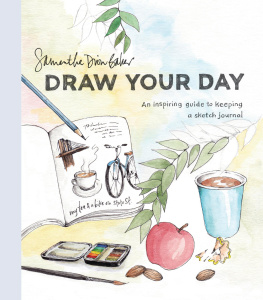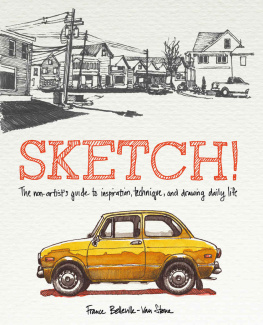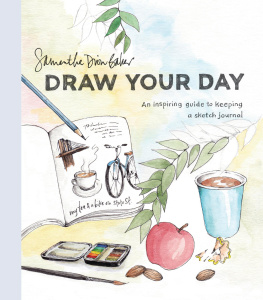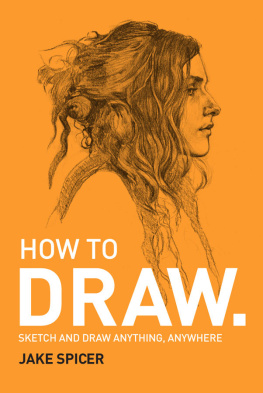Table of Contents
Guide
Contents
Why I Wrote This Book
Do you like drawing pictures?
This book is for those of you who loved doodling as a child, but for one
reason or another you gave it up once you became a busy adult. I carry
a notebook and pen with me wherever I go, and in this book I will show
you how easy it is to start enjoying the creative expression of sketching
once again.
Sketching may sound difficult, but once you start, youll find its lots of
fun! Your drawings dont have to be incredibly realistic and its fine if
your lines wander or are out of place. I encourage you to start drawing
in place of taking notes.
I hope that this book will inspire you to begin sketching and that you
enjoy practicing it often, whether it is at a daily meal, in a quaint village
while on vacation or wherever you are when the creative urge strikes!
Kimiko Sekimoto
People and Things in the City
Tools to Have on Hand
Good Pens
Its best to use a water-based, water-resistant felt-tip pen. The ones I use in this
book are the Mitsubishi (Uni) water-based ribbed pen Medium MYT-7 and Extra
Fine L-50, as well as the Pilot Super Petit Medium and Fine point. Once the ink of
water-resistant pens dries, even if it gets wet after, it doesnt run. So if you use
paint to add color, the lines will still stand out clearly. I dont use oil-based pens
because the ink tends to bleed through the paper.
The thickness of the lines
Im often asked what thickness of pen tip to use, but I dont have any outright
recommendation. Its fine to choose a tip with a thickness and flexibility that you
like. If youre not sure, take a look at your own notebook. If you write in tight fine
print, then use a fine-tip pen. If your writing is big and bold, try a pen with a thicker
tip. The main thing is to find a pen with a thickness you find easy to draw with, and
then also have a finer-tipped pen to add in details.
Here, a fine-tip pen has been used
(Pilot Super PetitFine Point). It
makes it easier to include small
details like the blocky text.
Here, a bold-tip pen has been
used (Mitsubishi water-based
pen, ribbedMedium).
Notebooks
There are many different types and sizes of notebook available. To begin with, try
drawing in the notebook you normally use. When buying a new one, I recommend
the ones that have unruled blank pages. If you will be using color, like for a lunch
diary, a watercolor sketchbook is good too.
Paints
When adding color to your
sketch notes, you will need
transparent watercolor paint,
a brush, a palette and tissue.
While traveling, if you have
transparent watercolors, a
watercolor brush pen and
pocket tissues, that is fine. You
can also use colored pencils.
Learn how to add color to your
sketches on pages 70-73. Use
that information to give it a try.
Basic Techniques
Start by practicing lines to get
used to drawing with a pen.
Its useful to remember some
helpful tips too.
Refer to the following pages while
you practice drawing on paper.
My Summer Vacation Journal
Warm-up Practice
If this is the first time youve drawn pictures or its been a long time since you
have, its best to start with some warm-up practice. When sketching, the brain tells
the hand how to draw what the eyes see and the hand uses the pen to put it down
on the paper. This section gives you basic training to get used to and improve
moving the pen with your hand and create smooth coordination between your
eyes, brain and hand.
Drawing circles, ellipses and ovals
In order to draw circles the size you want them, start by lifting your hand off the
paper and drawing a circle. Start with a small circle and then practice drawing
larger and larger ones. If you find closing up the outline of the circle difficult, focus
on returning to the same start point each time. Once you can draw circles, next try
ellipses and ovals. Practice drawing the curves so that the top and bottom ones
match. If it looks like the rim of a cup, youve perfected it.
Practice for ellipses (left), circles (top right) and ovals with different curves
(bottom right).
Add coffee to the cup
After drawing a coffee cup using an
ellipse, try drawing the surface of the
coffee in the cup. How is it? Theres
something a little off with the drawing
on the left. The drawing on the right
shows that when the curve of the cup
and the coffee match, it looks like a
natural surface of liquid.
Drawing squares, rectangles and parallelograms
Start by drawing a rectangle, and then draw a second one with the lines slightly
tilted to create a parallelogram. Keep drawing rectangles parallelograms, tilting the
lines more and more. Next, draw a square, and again keep drawing more, gradually
flattening the lines, to form a diamond shape. Try drawing the lines at various
angles but with opposite sides that run parallel to each other.
Items formed with ellipses
Items formed with rectangles and parallelograms
The ABCs of Notebook Sketching
Notebook sketches should include what you want to convey, while leaving out
any unnecessary information. If youre going for impression rather than accuracy,
sketch loosely to give an overall image, but if you want more accuracy and detail
for specific items, just put down that information and leave out the rest.
Observing carefully to decide the angle
Look at an item from all directions and think about which side you want to capture
in your sketch. Its easier to draw from an angle that shows three sides as it will
convey three-dimensional information, whereas its more difficult to express
realism if you only draw one or two sides. On the other hand, if you want to show
the lettering and illustrations on packaging, you should make the surface larger.
Sometimes I only draw the front face.
When you want to express volume, draw an object from an angle where you can see both
the top and two sides, When you want to sketch a label in detail, draw it from the front.
Draw a cup from the side to show the pattern (left); from an angle to show the volume of the
cup (center); and from the top to capture interesting latte art (right).
Where to start?
Basically, start with the part you want to show. If there are several elements
overlapping, start by drawing the top one. When drawing objects that overlap each
other or you want to clearly show which is in the front and which is in the back,
observe the top and front sides carefully. These will be visible, while the bottom
and back sides will be hidden.
Draw the featured shape
For a simple straw hat, begin with the shape (left), while for an eye-catching decorative hat,
start with the decoration.
Draw knowing that some parts will not be shown
For playing cards, start with the top card.
For scissors, begin with the top blade.
To draw a mesh pattern, look carefully at the way it is layered and draw it in order.
Drawing the lines
Although an objects outline may be very beautiful, sketching it with lines can








